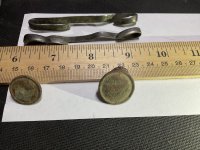The lightweight metal detector Rover UC allows treasure hunting in rough terrain, since only a smartphone is required for the first evaluation of the measured data. Without much preparation, the metal detector is immediately ready-to-use and does not only detect metals, but also distinguish between ferromagnetic and non-ferromagnetic metals.
In this case, the Rover UC detected a cavity while treasure hunting in the Middle East: A hidden burial chamber at 2 m depth was found in an ancient temple ruin. The treasure hunter was astonished as his discovery revealed valuable objects that are not made of gold. With the 3D ground scan function, his Rover UC tracked down the underground vault and led the treasure hunter to a successful discovery. The smartphone with the Rover UC App finally became a light source to illuminate the treasure find.
The discovered glass mosaic bowl with a diameter of 14.5 cm and a height of 4.5 cm weighs about 145 g, according to the treasure hunter. At first sight, the bowl appears to be very detailed, but rather inconspicuous in color. On closer inspection, the artfully arranged glass stones stand out, revealing their full splendor only above a light source: A beautiful, green shining mosaic showing fish around a spiral-shaped center. The discoverer of this treasure find describes the art object as a Phoenician glass mosaic bowl.
The glass production was originally brought to Egypt by craftsmen from Mesopotamia. Syria and Mesopotamia became important centers of glass production in the Mediterranean region in the 9th century BC. In the Hellenistic period, i.e. in the reign of Alexander the Great, Egyptian glass works in Alexandria again acquired a leading role. From there the technique of glass processing finally reached Rome.
Early on it was possible to make open vessels such as jugs and bowls from colored, translucent glass stones. Together with the mosaic technique, complex patterns were created, as the presented treasure trove shows. By fusing glass threads together, further forms and stripes could be created.
In fact, the Phoenicians were not only sovereign in the production of beautiful glass mosaic bowls, but also in the trade with the extraordinary objects. The entire Mediterranean area was supplied from the glass manufactories in the coastal towns in today’s Syria. The utility glass from Sidon and the glass artworks from Alexandria were exported in large quantities to Rome.
In its peak between 1200 and 900 BC, Phoenicia dominated the entire Mediterranean region as far as the Atlantic and was thus the greatest trading and naval power of antiquity. Phoenicia was famous in the ancient world mainly for its textiles and dyes (purple), objects made of precious metals, ivory carvings and glassware and had a significant influence on Greek art. Impressed by the production of glass, art spread throughout the Roman Empire and brought glass objects via the Silk Road to China.
You can buy our detectors here
In this case, the Rover UC detected a cavity while treasure hunting in the Middle East: A hidden burial chamber at 2 m depth was found in an ancient temple ruin. The treasure hunter was astonished as his discovery revealed valuable objects that are not made of gold. With the 3D ground scan function, his Rover UC tracked down the underground vault and led the treasure hunter to a successful discovery. The smartphone with the Rover UC App finally became a light source to illuminate the treasure find.
The discovered glass mosaic bowl with a diameter of 14.5 cm and a height of 4.5 cm weighs about 145 g, according to the treasure hunter. At first sight, the bowl appears to be very detailed, but rather inconspicuous in color. On closer inspection, the artfully arranged glass stones stand out, revealing their full splendor only above a light source: A beautiful, green shining mosaic showing fish around a spiral-shaped center. The discoverer of this treasure find describes the art object as a Phoenician glass mosaic bowl.
The glass production was originally brought to Egypt by craftsmen from Mesopotamia. Syria and Mesopotamia became important centers of glass production in the Mediterranean region in the 9th century BC. In the Hellenistic period, i.e. in the reign of Alexander the Great, Egyptian glass works in Alexandria again acquired a leading role. From there the technique of glass processing finally reached Rome.
Early on it was possible to make open vessels such as jugs and bowls from colored, translucent glass stones. Together with the mosaic technique, complex patterns were created, as the presented treasure trove shows. By fusing glass threads together, further forms and stripes could be created.
In fact, the Phoenicians were not only sovereign in the production of beautiful glass mosaic bowls, but also in the trade with the extraordinary objects. The entire Mediterranean area was supplied from the glass manufactories in the coastal towns in today’s Syria. The utility glass from Sidon and the glass artworks from Alexandria were exported in large quantities to Rome.
In its peak between 1200 and 900 BC, Phoenicia dominated the entire Mediterranean region as far as the Atlantic and was thus the greatest trading and naval power of antiquity. Phoenicia was famous in the ancient world mainly for its textiles and dyes (purple), objects made of precious metals, ivory carvings and glassware and had a significant influence on Greek art. Impressed by the production of glass, art spread throughout the Roman Empire and brought glass objects via the Silk Road to China.
You can buy our detectors here



